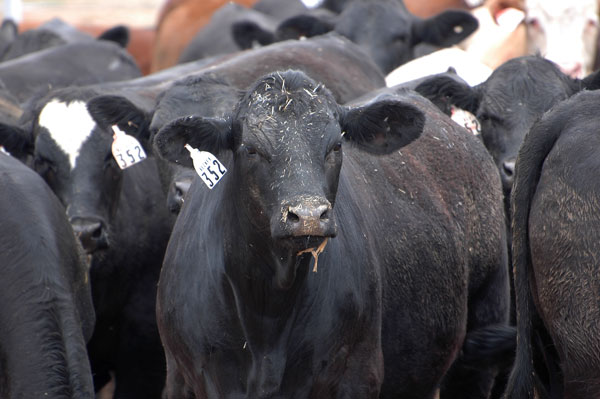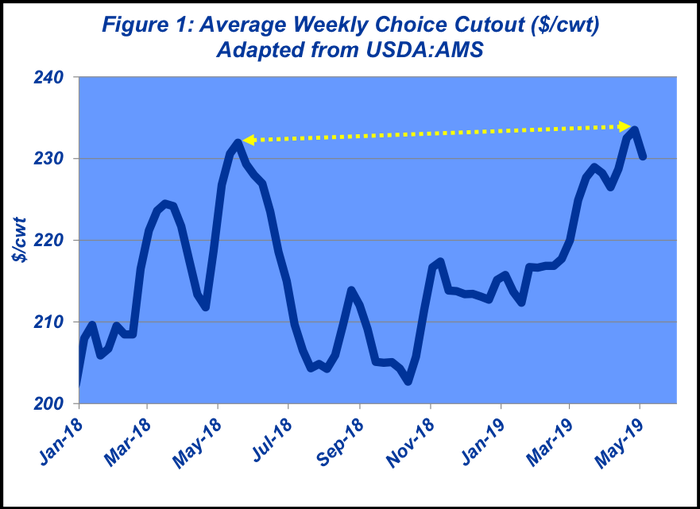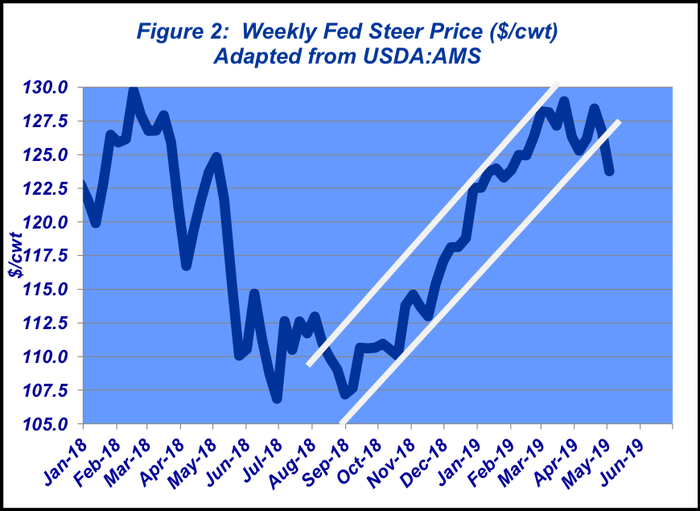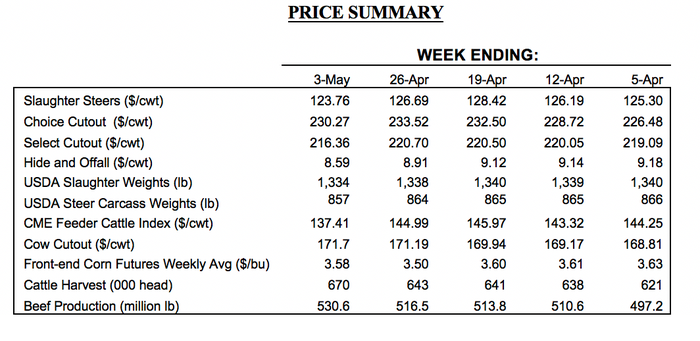Fed prices surprisingly strong in April. Will the trend hold?
The May fed market is pressured by looming larger supply of fed cattle.
May 8, 2019

Well, it wasn’t a new high….but it darn sure got close. Either way, it’s not one week, or one price, that really matters – it’s the broader trend that makes a difference. To that end, April proved to be remarkably resilient, especially given it all started on a softer note.
Recall that March fed cattle prices ended with a $2-3 per cwt slide, and then April opened down another $1. It seemed April’s market was certain to be fighting softer prices on the way to summer lows – it was just a matter of how that fight took shape. But as noted last month, there was also still some hope for better prices.
Sure enough, fed trade caught some tail winds. The market fought its way back to $126 per cwt and then to $128 (weighted average) during the middle weeks of the month. The month closed on an uneven note as prices ranged widely during the week but still managed to average $126-127.
As such, April was a very good month and solidified stronger fed prices on a year-over-year basis. The April fed market averaged $6 per cwt ahead of last year.
Moreover, fed trade through the end of April has averaged nearly $126 per cwt, versus fed cattle bringing just north of $124 in 2018. Best of all, those better prices have come against slightly larger kill volume and beef production compared to the same period last year. May started with a weekly kill of 670,000 head – the largest single-week throughput since fall 2011.
Consumer confidence
Stronger prices in April are directly attributable to improving cutout values. The cutout has enjoyed a favorable surge in recent weeks – and thus largely responsible for renewed strength on the live side. The index jumped above $230 for the first time since last May – and managed to surpass last year’s weekly peak of $232 (Figure 1).

Clearly, consumers are perceiving beef favorably in the marketplace. Moreover, the economy continues to underpin beef spending. And there’s no reason those conditions shouldn’t continue to be supportive.
Most notably, the American Institute of CPA’s quarterly Personal Financial Satisfaction Index is up 27% versus the same reading in 2018. Consumers are seemingly confident with respect to employment and perceive the economy to be in good shape. All of that was further reinforced by April’s strong jobs report.
Supply pressure looms
Meanwhile, not unexpectedly, May opened on a softer note with steers and heifers settling at mostly $123-124 per cwt. More important to the broader trend, that price level violated the upward trending channel (Figure 2). And with the transition to May, cattle feeders are now navigating downward pressure from the CME with June as the front month contract.

USDA’s Cattle on Feed report reinforced the work that’s ahead with respect to supply. The April 1 inventory was pegged at 11.964 million head – the largest April number on record. It’s also 2% and 9% ahead of last year’s market and the five-year average, respectively.
But most important, the front-end remains sizeable. The 120-day plus inventory of cattle equaled 4.63 million head on April 1; that represents an additional 530,000 head versus the five-year average that need to be marketed in the next several months.
Marketplace collusion?
Major news of the month comes on the legal front with the R-CALF USA class action lawsuit against Tyson, Cargill, JBS and National. The lawsuit has seemingly emboldened some observers about market dynamics. To that end, one commentator noted:
"Well, it’s not big news that your packers collude to try and keep prices down. They’re trying to buy ‘em as cheap as they can. And, it’s not unusual for that to happen in a week…It’s kind of hard to believe they can all be that close if they’re not colluding together at some point."
Collusion is a very serious accusation – and to casually accuse such without any direct evidence is nothing short of reckless.
Much of the concern revolves around captive supplies and the declining level of cash trade establishing the weekly market. That wasn’t a concern when prices were going up (e.g. 2013 and 2014).
However, Industry At A Glance addressed the issue earlier in the year. The impetus stemmed from the Organization for Competitive Markets petition against the USDA regarding the agency’s plan to withdraw implementation of the GIPSA Farmer Fair Practices Rules. There were three columns in the series highlighting the relationship between cash trade and:1. Cash trends; 2. Volatility, and; 3. Basis.
In general, cartels are notoriously ineffective because at least one party always departs from the agreement – protecting self-interest becomes the enduring driver regardless of any agreement. With that in mind, on one hand, R-CALF asserts packers recorded historic margins beginning in January 2015 – due to collusion (i.e. four-company cartel).
On the other hand, the lawsuit claims the packing industry conspired to slow down throughput. Based on typical cartel behavior, those positions are inherently hard to reconcile. That’s further reinforced when considering the principles of cost-volume-profit analyses within large firms.
At the same time, some concerns about the fed market often invoke the issue of producer share of the retail dollar. That’s been the focus for Industry At A Glance during the past several weeks. The first column addresses the topic from a broader perspective; the second provides some context around producer share and feedyard profitability. Most significant, a paper written by Brester, Marsh and Atwood (Montana State University, 2009) summarizes the topic this way: “The lack of informational content in [farmer share] statistics suggests these data should not be used for policy purposes.”
To close, last month’s column included discussion based on Behavior Gap: the website was started by Carl Richards, a Certified Financial Planner who makes careful study of human behavior. He’s a teacher at heart through his simple sketches (his “Sketch Guy” column has run in the New York Times since 2010).
One of my very favorites is a simple Venn diagram. The left circle is labeled, “Things that matter;” the one on the right, “Things you can control.”
The overlap between them is very small. And it’s in that small intersection Richards instructs us, “What you should focus on.” That’s a great daily reminder for all of us in any business.
To that end, this column always encourages beef producers to invest time AND resources into obtaining objective information and reviewing that information carefully. Doing so ensures you’re spending time and energy on “what you should focus on” and ultimately (as referenced last month) “you’re making good decisions.”
Speer serves as an industry consultant and is based in Bowling Green, Ky. Contact him at [email protected]

About the Author(s)
You May Also Like




.png?width=300&auto=webp&quality=80&disable=upscale)
